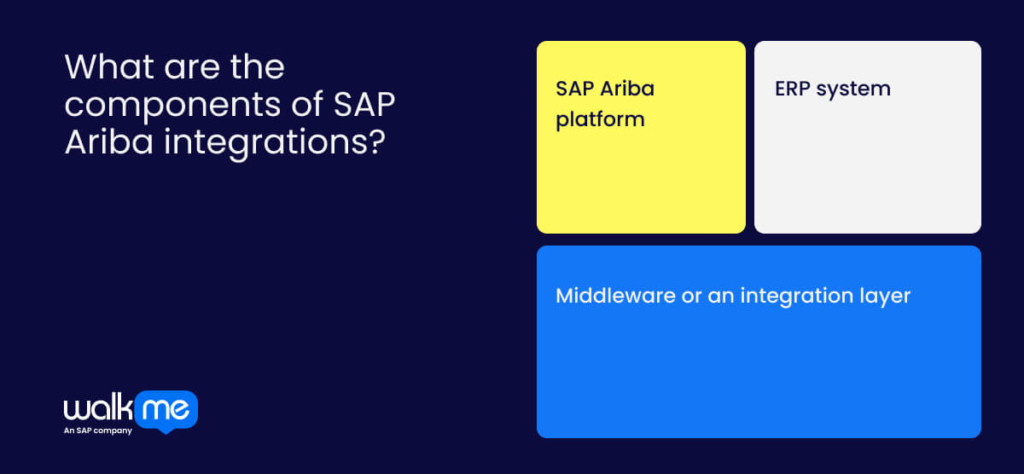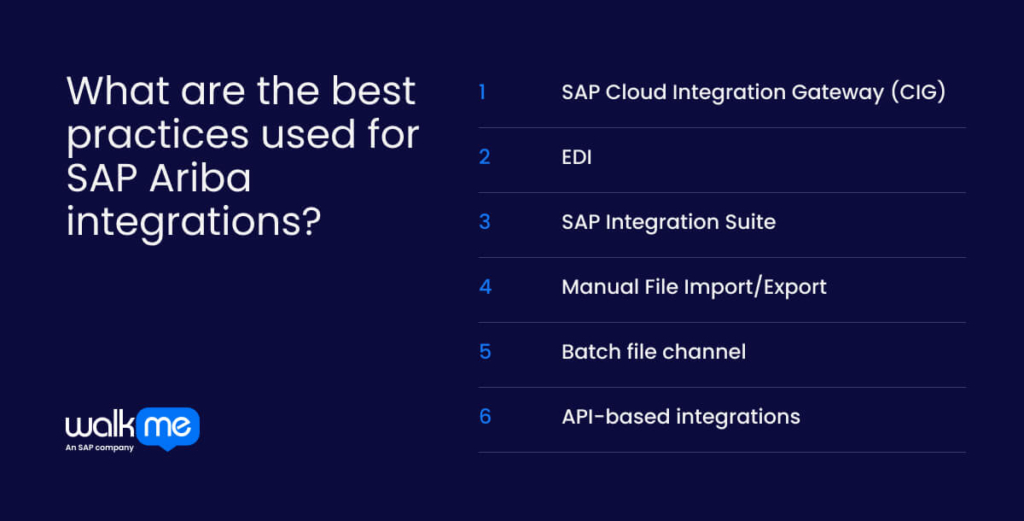Companies often handle large amounts of unstructured data, including spending trends and supplier information. This makes the procurement process prone to errors and hard to manage.
As technology continues to improve, more businesses are leveraging digital tools to reduce procurement challenges. SAP Ariba integrations, an example of these tools, help within this by connecting Ariba with ERP systems and supplier networks.
This reduces mistakes, saves time, and improves efficiency. It also enables teams to manage the entire procurement process in one place. This provides real-time insights into spending and supplier performance.
In this article, we will examine what SAP Ariba integrations are, their key components, best practices, and use cases.
What are SAP Ariba integrations?
SAP Ariba integrations are cloud-based tools that help connect both SAP and non-SAP systems to improve procurement, supply chain, and spend management. Tools like SAP Ariba Cloud Integration Gateway (CIG) and SAP Business Network support various integration needs.
This type of integration helps reduce manual tasks by automating the processing of purchase orders and invoices. It also enhances data visibility across the entire procurement process.
Ariba connects different departments and partners, helping teams work together more efficiently. It speeds up sourcing and bidding with tools like online auctions and helps companies handle supplier onboarding and performance monitoring.
Organizations can also benefit from better spend control, policy compliance, and on-time payments by streamlining invoice processing. For example, integration with ERP systems like SAP S/4HANA ensures consistent data, while its automation features improve overall efficiency.
What are the components of SAP Ariba integrations?

Here are the key SAP Ariba integration components:
SAP Ariba platform
SAP Ariba is a cloud-native platform that enables companies to manage their spending and procurement processes. It works with native tools and other systems to simplify the entire procure-to-pay cycle.
Integration options include the SAP Ariba Cloud Integration Gateway, which links a company’s SAP system with Ariba. It considers the SAP Integration Suite, which connects cloud and on-premise apps using built-in tools. Ariba can also connect with ERP systems to process documents, such as orders and invoices.
ERP system
SAP Ariba’s ERP integration connects its procurement tools with a company’s core system. This link enables seamless data flow and automates tasks, such as invoice approval.
It also provides real-time visibility into procurement activities. Ariba can exchange key data, including orders, invoices, contracts, and supplier information. Integration methods include direct connections using file uploads or transfers, as well as the SAP Cloud Connector for secure cloud-to-ERP communication.
Middleware or an integration layer
In SAP Ariba integrations, middleware is a software layer that connects Ariba with other systems, such as SAP or non-SAP platforms. It enables different applications to share data and work together. A typical example is SAP Integration Suite, which offers tools to manage these connections.
Middleware simplifies integration and enables flexible setups to meet evolving business needs. It also supports scalability as the company grows. With built-in monitoring and management tools, middleware facilitates the tracking and resolution of issues.
What are some examples of SAP Ariba integrations?
Here are some ways to utilize SAP Ariba integrations within a business:
Supplier onboarding and management
SAP Ariba integrations, such as Supplier Lifecycle and Performance (SLP), facilitate supplier management by simplifying the onboarding process. Suppliers can use self-service portals to share their information.
This type of procurement software automates approvals and ensures consistent supplier data. It also integrates with other Ariba tools, such as SAP Ariba Contracts, allowing risk checks on contract requests.
Purchase order (PO) generation & management
Businesses can automate purchase orders by creating purchase orders (POs) from approved requests and guided buying using SAP Ariba integrations. They enable real-time supplier collaboration through the Ariba Network, manage invoices, and update purchase order (PO) statuses. Integration also sends PO closure info to ERP, ensuring accurate tracking and efficient procurement management.
Sourcing and RFQ (Request for Quotation) management
SAP Ariba integrations help streamline sourcing and RFQ management by connecting ERP systems with Ariba Sourcing. It begins with sending RFQs created in SAP S/4HANA to Ariba, where they can be managed and processed for sourcing events.
Suppliers submit bids, and once an award is made, the data goes back to the ERP to generate a purchase order. This process promotes compliance and enables businesses to save costs through more effective supplier negotiation..
Spend analysis and reporting
Organizations can collect and analyze spending data through integrations with SAP systems, such as SAP ERP and S/4HANA. They pull data from sources such as purchase orders, invoices, and contracts. Ariba classifies and enriches this data using machine learning and supplier databases.
Companies can utilize built-in reports and dashboards to monitor supplier performance and make sourcing decisions based on accurate spend insights.
What are the best practices used for SAP Ariba integrations?

These are the best practices for SAP Ariba integrations:
SAP Cloud Integration Gateway (CIG)
The SAP Ariba Cloud Integration Gateway (CIG) is a tool that connects SAP Ariba with native new and legacy applications, as well as non-SAP platforms. It simplifies integration by using one central gateway, reducing the need for custom code. CIG supports APIs, automates procurement tasks, and improves communication between buyers and suppliers through the Ariba Network.
It also includes user-friendly tools that enable teams to set up, test, and manage integrations without requiring technical skills. With CIG, companies can accelerate integration, reduce costs, and remain flexible as their business and technology needs evolve.
EDI
EDI, or Electronic Data Interchange, lets systems like SAP and Ariba exchange business documents automatically. It utilizes standard formats such as X12, EDIFACT, or cXML, allowing different systems to read and send data. With EDI, the ERP system connects directly to the Ariba Network, removing the need for portals or manual uploads.
It also sends and receives documents, such as purchase orders, shipping notices, and invoices, without requiring human input. By utilizing standardized formats and automating the process, EDI facilitates more effective communication. This helps make supply chain management more efficient.
SAP Integration Suite
The SAP Integration Suite, particularly its Managed Gateway feature, facilitates a faster connection of systems to SAP Ariba. It offers no-code integration, self-service tools, and automatic testing to help create reliable connections.
This type of integration method also connects back-end ERP systems to the SAP Business Network, simplifying the process. Back-end ERP systems handle essential tasks, such as data processing and system functions.
Manual File Import/Export
Manual import and export in SAP Ariba enable users to transfer data files, typically in CSV format, through the Ariba interface. This helps transfer data between systems or handle specific tasks inside Ariba. It is useful for small updates, testing, or moving data from old systems during setup or migration.
This method provides users with more control and a deeper understanding of their data. It can be cheaper than full integration for small tasks. But, it is slow for large or complex data, requires manual work, and is not suitable for real-time syncing.
Batch file channel
The Batch File Channel in SAP Ariba utilizes CSV files transmitted over HTTPS to transfer large datasets automatically. It reduces manual work and errors, speeds up processes, and improves visibility into goods and invoices.
API-based integrations
SAP Ariba’s APIs enable developers to connect systems, automate tasks, and build custom applications. This speeds up procurement, cuts costs, and improves supplier communication. APIs also enhance employee productivity by consolidating data for improved reporting and analysis.
Why SAP Ariba integrations matter for business success
SAP Ariba integrations simplify procurement and reduce manual work. By connecting Ariba with other systems, companies get real-time, accurate data across purchasing and finance. This leads to better decisions and stronger teamwork.
IT leaders help build these connections to meet business and technical needs. When done right, integrations support long-term business resilience. With the correct setup, Ariba becomes a powerful tool for digital procurement.
FAQs
SAP Ariba integrations help businesses streamline purchasing, track spending and supplier performance, and adhere to regulations. They also enhance teamwork and reduce costs by integrating systems.
SAP Ariba is a cloud tool that helps manage buying and spending. It often integrates with other systems, such as ERP tools (e.g., SAP ERP and SAP S/4HANA), supplier systems, and external trading partners.

